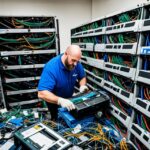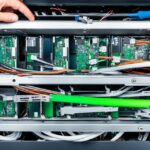The Benefits of Integrating Server Recycling into IT Lifecycle Management
In today’s data-driven economy, data centres play a crucial role, but they also contribute to the environmental crisis. The emissions from these data centres are projected to double by 2040, with servers alone accounting for up to 26% of data centre energy consumption. While many studies focus on energy usage and waste in server lifecycle management, little attention has been given to the manufacturing and deployment phases.
Integrating server recycling into IT lifecycle management brings about a host of benefits. It not only increases efficiency and reduces waste but also helps lower costs and achieve environmental goals. By actively recycling servers, businesses can make a significant impact on the overall sustainability of their operations.
By incorporating server recycling into IT lifecycle management, companies can effectively address the problem of e-waste and reduce their carbon footprint. In addition, this integration allows for the responsible management of the entire lifecycle of a server, from its creation to its eventual retirement and recycling. It is a holistic approach that supports sustainability and ensures a brighter future for the planet.
Stay tuned as we explore the various aspects of server recycling and its integration into IT lifecycle management. Discover how this approach can make a significant difference in efficiency, waste reduction, and environmental impact.
The Problem of Server Under-utilisation
A report by the Natural Resources Defense Council (NRDC) estimates that servers have an average utilisation rate of 12-18%, leading to avoidable e-waste. Recycling spare compute capacity on a global network can distribute workload demand and increase utilisation.
Server under-utilisation is a significant challenge in modern data centres. Despite the increasing demand for computational power, servers often operate at a fraction of their capacity, resulting in wasted resources and unnecessary environmental impact.
“The under-utilisation of servers contributes to the growing problem of electronic waste,” says John Watson, a sustainability expert at NRDC. “We need innovative solutions that can optimise server usage and reduce the ecological footprint of data centres.”
One potential solution lies in recycling spare compute capacity. By leveraging a global network of idle servers, workload demand can be distributed more efficiently. This approach not only improves server utilisation but also reduces the pressure on individual data centres, leading to lower energy consumption and emissions.
Blockchain technology plays a pivotal role in enabling transparent and compliant spare capacity recycling. By using a blockchain-enabled platform, companies can ensure the seamless and secure sharing of unused computing power. The transparency and immutability of blockchain provide confidence to both providers and users, creating a reliable and sustainable spare capacity marketplace.
The Benefits of Blockchain-Enabled Spare Capacity Recycling
- Transparency and accountability: Blockchain technology allows for a transparent and auditable record of spare capacity transactions. This ensures that providers are properly compensated for their resources and that users can trust the integrity of the shared compute power.
- Low-latency compute solutions: By leveraging spare capacity distributed across a global network, users can access high-performance compute resources with low-latency. This enables more efficient and responsive computing, benefiting a wide range of applications such as artificial intelligence, data analysis, and scientific research.
- Environmental sustainability: Spare capacity recycling significantly reduces the need for new server deployments, which in turn reduces energy consumption and electronic waste. By reusing existing resources more effectively, companies can achieve their sustainability goals and contribute to a greener future.
With the problem of server under-utilisation becoming increasingly evident, it is imperative to explore innovative solutions that promote resource efficiency and environmental sustainability. Blockchain-enabled spare capacity recycling offers a promising pathway towards achieving these goals, revolutionising the way we utilise computing power and reducing the ecological impact of data centres.
Achieving Sustainability through Spare Capacity Recycling
Optimising server usage, recycling spare capacity, and ensuring accountability are essential for sustainable lifecycle management. By embracing spare capacity recycling, businesses can make significant contributions to sustainability and environmental preservation.
Increasing server utilisation by 20% can have a profound impact on both the environment and resource consumption. It can eliminate the need for one-sixth of the servers that are currently procured, which in turn reduces the energy consumption associated with manufacturing and transportation processes.
But how can businesses go beyond server optimization to achieve even greater sustainability? Monetising idle hardware presents a unique opportunity to further reduce wastage and harness the potential of underutilised resources.
Monetising Idle Hardware: Unlocking the Potential
Idle hardware, such as GPUs and video-game consoles, are often overlooked assets that hold immense potential for sustainability. These devices have significant computing power that can be repurposed to contribute to spare capacity recycling initiatives. By monetising idle hardware, businesses can not only reduce electronic waste but also generate revenue while actively participating in sustainable practices.
“Optimising server utilisation and recycling spare capacity are crucial for achieving sustainability in IT lifecycle management.”
Implementing spare capacity recycling initiatives requires a commitment to accountability and transparency. Businesses must ensure that reused computing resources are deployed in compliance with established standards and best practices. This can be achieved through the use of blockchain-enabled platforms, which offer transparency, security, and low-latency compute solutions.
By embracing spare capacity recycling and monetising idle hardware, businesses can dramatically improve their sustainability efforts while reducing costs and enhancing efficiency. Through responsible IT lifecycle management, they can make tangible contributions towards mitigating the environmental impact of the data-driven economy.
The Economic Incentives of Spare-Capacity Recycling
As technology continues to advance, the need for efficient and sustainable computing solutions becomes increasingly important. Spare-capacity recycling models are emerging as a way to address this need while also creating economic incentives for businesses. Through the redistribution of cloud computing revenue, spare-capacity recycling opens up new possibilities for generating revenue and reducing the environmental impact of underutilised hardware.
One of the key advantages of spare-capacity recycling is the ability to utilise various hardware and devices in the network, including CPUs, GPUs, PCs, and mobile devices. By harnessing the computing power of these resources, businesses can effectively redistribute workloads and optimise resource usage.
“Spare-capacity recycling offers a practical and sustainable solution to the challenges posed by underutilised hardware,” says Tim Smith, CEO of Cudo Compute, a leading provider of spare-capacity recycling solutions. “By leveraging idle hardware, businesses can not only generate revenue but also contribute to creating a more sustainable planet.”
“Idle hardware monetisation can significantly reduce e-waste and the environmental footprint associated with manufacturing new devices,” explains Smith. “This creates a win-win situation where businesses can maximise their resources and make a positive impact on the environment.”
By partnering with Cudo Compute, businesses and individuals can take advantage of the economic incentives provided by spare-capacity recycling. Cudo Compute’s platform enables the deployment of virtual machines on idle data centre hardware, offering high-powered computing and distributed resources at the edge. This not only benefits businesses financially but also contributes to a more sustainable and efficient IT ecosystem.
Economic Benefits of Spare-Capacity Recycling
| Benefits | Description |
|---|---|
| Revenue Generation | Earn additional income by monetising idle hardware |
| Cost Reduction | Eliminate the need for procuring additional servers and reduce energy consumption |
| Environmental Impact | Minimise e-waste and lower the carbon footprint associated with manufacturing |
| Optimised Resource Usage | Ensure efficient allocation of computing resources and maximise productivity |
About Cudo Compute and IT Lifecycle Management
Cudo Compute is a fairer cloud computing platform that utilises underutilised computing resources on idle data centre hardware. It allows organisations and developers to deploy virtual machines on a democratised cloud platform, leveraging high-powered computing and distributed resources at the edge. By integrating Cudo Compute into IT lifecycle management, businesses can achieve greater sustainability and efficiency.
The Benefits of Cudo Compute for IT Lifecycle Management
Cudo Compute offers significant advantages when integrated into IT lifecycle management processes. Here are some key benefits:
- Optimised Resource Utilisation: By utilising underutilised computing resources, Cudo Compute maximises server efficiency, reducing waste and lowering costs.
- Sustainability and Environmental Impact: By repurposing idle data centre hardware, Cudo Compute reduces the need for new server procurement, minimising the environmental footprint of manufacturing and transportation processes.
- Democratised Cloud Platform: Cudo Compute provides a fairer cloud computing platform for businesses and developers, allowing them to leverage high-powered computing and distributed resources at the edge.
Integration Process with IT Lifecycle Management
Integrating Cudo Compute into IT lifecycle management involves a seamless process that ensures efficiency and sustainability throughout the entire lifecycle. Here’s a step-by-step guide:
- Assessment: Evaluate the existing IT infrastructure to identify underutilised computing resources and determine the potential for resource optimisation.
- Implementation: Integrate Cudo Compute into the IT infrastructure, enabling the deployment of virtual machines on idle data centre hardware.
- Monitoring and Management: Regularly monitor and manage the performance of the integrated system, ensuring optimal resource utilisation and sustainability goals are met.
- Reporting and Analysis: Analyse data on resource utilisation, cost savings, and environmental impact to drive continuous improvement and identify areas for further optimisation.
By following this integration process, businesses can harness the benefits of Cudo Compute and leverage its capabilities to drive sustainability, cost efficiency, and resource optimisation within their IT lifecycle management.
Industry Case Study: Implementing Cudo Compute for IT Lifecycle Management
“Integrating Cudo Compute into our IT lifecycle management process has revolutionised our resource utilisation and sustainability efforts. We have seen a significant reduction in server underutilisation, resulting in substantial cost savings and environmental impact reduction. Cudo Compute’s fair and democratised cloud platform has empowered our developers to leverage high-powered computing resources efficiently.”
– Emma Green, CTO of Tech Solutions Ltd
Key Features and Advantages of Cudo Compute
| Feature | Advantage |
|---|---|
| Utilisation of idle data centre hardware | Maximises resource efficiency and reduces waste |
| Democratised cloud platform | Enables access to high-powered computing and distributed resources at the edge |
| Cost savings | Reduces the need for new server procurement |
| Environmental sustainability | Minimises the environmental impact of server manufacturing and transportation |
By implementing Cudo Compute in IT lifecycle management, businesses can unlock these key features and advantages, driving sustainability, efficiency, and cost savings.
Conclusion
Integrating server recycling into IT lifecycle management brings a multitude of advantages. It enhances efficiency, reduces waste, lowers costs, and fosters environmental sustainability. By incorporating practices such as recycling spare compute capacity and monetising idle hardware, businesses can optimize their resource usage and play an active role in creating a more sustainable planet.
Cudo Compute, a leading cloud computing platform, offers a solution for implementing these practices. It provides a platform that empowers both businesses and individuals to embrace IT lifecycle management integration. By leveraging Cudo Compute, organizations can harness underutilized computing resources on idle data center hardware, deploying virtual machines and accessing high-powered computing capabilities in a fair and democratised cloud platform.
By embracing IT lifecycle management integration and leveraging the capabilities of Cudo Compute, businesses can contribute to a greener future. Through efficient resource allocation and responsible disposal of electronic waste, we can make significant strides in reducing the environmental impact of our technological advancements. It’s time to prioritize sustainability in IT, and Cudo Compute is here to help make it happen.
FAQ
How can integrating server recycling into IT lifecycle management benefit businesses?
Integrating server recycling into IT lifecycle management can increase efficiency, reduce waste, lower costs, and help businesses meet environmental goals.
What is the problem with server under-utilisation?
Servers have an average utilisation rate of 12-18%, leading to avoidable e-waste. This under-utilisation contributes to the environmental crisis.
How can spare capacity recycling contribute to sustainability?
Recycling spare compute capacity on a global network can distribute workload demand, increase server utilisation, and reduce the environmental impact of underutilised hardware.
What are the economic incentives of spare-capacity recycling?
Monetising idle hardware through spare-capacity recycling can generate revenue for businesses and individuals while reducing environmental impact.
What is Cudo Compute and how does it relate to IT lifecycle management?
Cudo Compute is a fairer cloud computing platform that utilises underutilised computing resources on idle data centre hardware. By integrating Cudo Compute into IT lifecycle management, businesses can achieve greater sustainability and efficiency.
What are the benefits of integrating server recycling into IT lifecycle management?
Integrating server recycling into IT lifecycle management offers numerous benefits, including increased efficiency, reduced waste, lower costs, and environmental sustainability.















